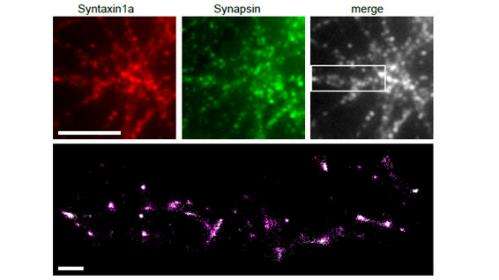Neurotransmission caught on camera

Scientists have captured the exact point and time when information is exchanged between brain cells, a breakthrough that could explain how and why neurological conditions like schizophrenia or epilepsy occur.
An international team, led by Professor Rory Duncan at Heriot-Watt University, has used new 'super-resolution' microscopy or 'nanoscopy' techniques to understand how synapses function and ultimately transmit information throughout the brain and nervous system.
These new results, published in Nature Communications, will lead to better understanding of synapses, the structures in nerve cells in the brain, at the single molecule level and perhaps pinpoint where and when certain neurological conditions begin. These molecules drive neurotransmission and the new microscope techniques allow them to be seen in action for the first time.
Professor Rory Duncan, an expert in molecular membrane biology and microscopy at Heriot-Watt University, said, "Until now, nobody has understood exactly how neurotransmission worked, because the techniques to analyse it were limited.
"We've developed sophisticated microscope methods to determine how synapses are regulated and function, in real time and with massive accuracy. The molecules we can see, and track in their thousands using mathematical approaches, are as small to us as Jupiter is large; these new 'super-resolution' techniques mean that biologists can at last see the things that make cells work.
"Once we understand how synapses function, in terms of the how, where and when of events, we will know what needs to change in order potentially to treat neurological disorders such as schizophrenia."
The team's new approaches use a distinctive combination of laser physics, mathematics, genetics and cell biology, 'fusing' genes from fluorescent jellyfish and corals to the genes that make the molecular drivers which underlie neurotransmission. Shining lasers on the proteins these fluorescent 'fusion proteins' make in living synapses allows the molecules to be seen in action.
More information: "A molecular toggle after exocytosis sequesters the presynaptic syntaxin1a molecules involved in prior vesicle fusion" Nature Communications 5, Article number: 5774 DOI: 10.1038/ncomms6774
















